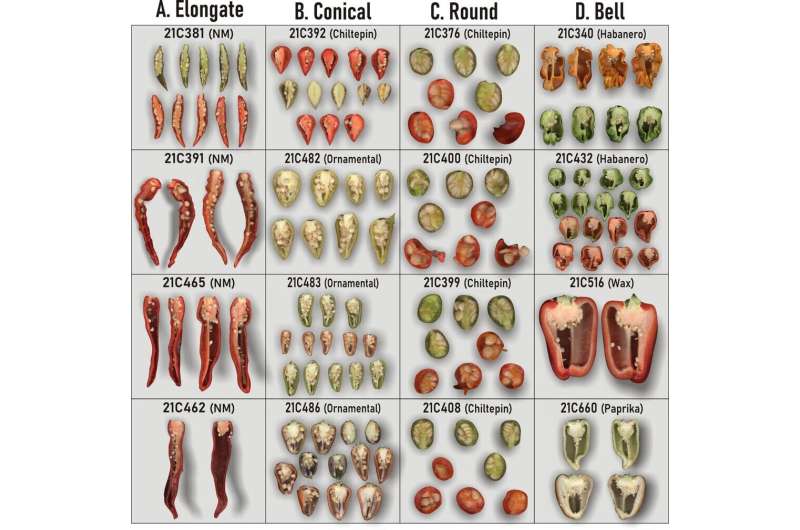This article has been reviewed according to Science X's editorial process and policies. Editors have highlighted the following attributes while ensuring the content's credibility:
fact-checked
peer-reviewed publication
trusted source
proofread
Tomato analyzer software reveals phenotypic diversity in New Mexican chile peppers

New Mexico is one of the largest producers of chile pepper (Capsicum spp.) in the United States, with 51,000 tons of production in 2021 from an area of 8500 acres with average productivity of 6 tons/acres according to the U.S. Department of Agriculture National Agriculture Statistics Service. The average productivity decreased by 25% as the area planted to chile pepper production remained the same. This resulted in a reduction in economic activity of almost 10% in 2020 compared with the previous year, from $50.1 million to $44.9 million. This significant decline in the total production of chile pepper in the state spurred scientists to new modernization efforts aimed at accelerating the genetic gain and improving productivity in the NMSU Chile Pepper Breeding and Genetics program by evaluating different traits related to yield and yield potential using high-throughput phenotyping tools such as the Tomato Analyzer (TA).
Fruit architecture and morphology-related traits are among the determinants of fruit diversity and are major contributors to yield and yield potential in chile pepper. Using the TA software, scientists collected data on a set of fruit attributes including fruit perimeter, shape indices, size, and asymmetry in a collection of diverse chile pepper lines evaluated under New Mexico growing conditions.
Researchers aimed to characterize 105 genotypes of a Capsicum diversity panel consisting of cultivars, breeding lines, landrace, and wild species belonging to 12 different pod (fruit) types, for 32 morphometric TA descriptors. Hierarchical cluster analysis grouped the genotypes into eight clusters based on the TA descriptors. The basic measurements—namely, perimeter, area, width mid height, maximum width, height midwidth, maximum height, and curved height— were the most discriminating descriptors with a maximum contribution to the overall fruit shape.
The usefulness of the morphometric TA descriptors, which are difficult to measure through conventional phenotyping, was demonstrated. Several cultivars with desired fruit shape and morphology based on cluster analyses were recommended as parental lines for hybridization to improve yield in chile pepper breeding programs. Results using the TA for measuring fruit-related traits will provide a basis for genome-wide association study and genomic selection for yield and yield-contributing traits in New Mexican chile pepper.
The full study results can be found on the ASHS HortScience electronic journal website.
More information: Ehtisham S. Khokhar et al, High-throughput Characterization of Fruit Phenotypic Diversity among New Mexican Chile Pepper (Capsicum spp.) Using the Tomato Analyzer Software, HortScience (2022). DOI: 10.21273/HORTSCI16815-22
Journal information: HortScience
Provided by American Society for Horticultural Science





















